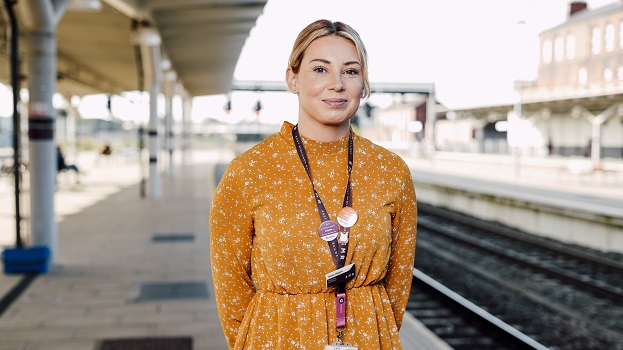Frontline staff in train operating companies (TOCs) play a crucial role in keeping our railway safe.

Above: Rebecca Higgins
Whether they report internally or through CIRAS, their voices always matter. Here, a CIRAS rep at one of our TOC members shares some thoughts on health and safety reporting and how CIRAS fits in with the company’s culture of listening.
How long have you been at East Midlands Railway and what do you do there?
I started at EMR in September 2022 as a safety data co-ordinator. I report safety data into SMIS, in line with Railway Group Standards. That includes data from health, safety, security and environmental events, including rolling stock defects.
I ensure there is a process in place to report accidents and incidents to the Office of Rail and Road and Rail Accident Investigation Branch in a timely way, as required by legislation. I do data quality checks and ensure there are procedures in place to validate data.
As well as being the CIRAS rep for EMR, I also manage the close calls process for obtaining responses and feeding back to reporters, including managing the close call inbox.
What do you think is the biggest barrier to people reporting health and safety risks?
I believe the biggest barrier to reporting is lack of the right technology and reporting methods. Some EMR staff do not have access to the technology they need to report at the time of the issue. I also think having digital reporting forms would encourage people to report more.
Why do you think CIRAS is important?
CIRAS is an alternative route for people to use to help solve health or safety issues that may not have surfaced through other channels. Coming forward can be daunting for some, but an external, independent route for reporting an issue could give confidence to that staff member. We want staff to report all matters with the confidence that they will be heard and that we will be looking into their issue in depth. We want to be able to understand why people might prefer some reporting channels to others, and CIRAS can give us insight into that. We also want to have the chance to investigate all health and safety concerns.
What kind of safety issues and themes are you seeing at EMR?
Over the past couple of years, we have endured extreme summer weather with temperature increases, then swiftly moving into the colder season with snow. The extreme winter weather raises concerns about ensuring our platforms and walking routes are gritted so that we have no slips or trips and snow is removed. Our various reporting routes help us to address these issues effectively, in real time.
Are there any things you think go unreported? If so, what?
I believe small issues, such as minor injuries and/or accidents where there are no injuries, go unreported. We encourage staff to report all accidents and any other issues – no matter how small – so we can investigate. Without the reports, we don’t have the data to review the issues in a wider context. Small issues can occur more often, which creates a larger risk, which is why it is so important to report all issues.
How do you raise awareness of CIRAS across your organisation?
We have used internal comms routes, such as email, to tell staff about CIRAS and the CIRAS reporting app. The Safety Performance team also takes part in the inductions where we talk about CIRAS alongside our other reporting methods. We invite our CIRAS stakeholder manager to our inductions so they have the opportunity to speak to new and old staff directly about CIRAS, what it is, and how they can help.
What response have you had, if any, to the launch of the CIRAS app?
We have had a positive response overall to the CIRAS app. Our workforce’s IT skills vary, but the app is simple and easy to use. That, in itself, breaks down some of the barriers to reporting. Many of our staff have some kind of company device, so they can download the app – it’s accessible and makes reporting a lot easier.
Tags
- Freight Operator
